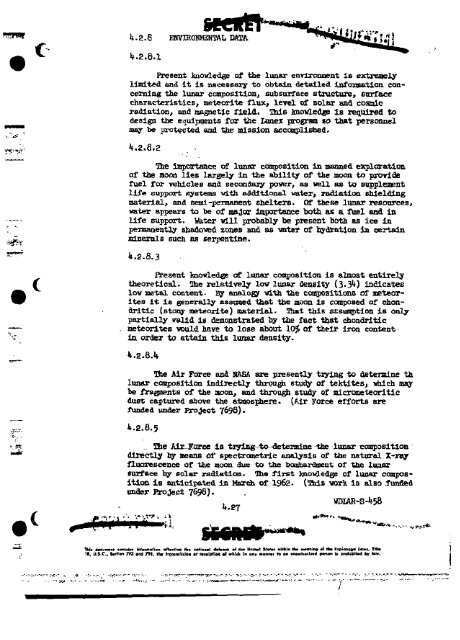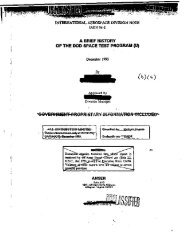LUNAR EXPEDITION PLAN
LUNAR EXPEDITION PLAN
LUNAR EXPEDITION PLAN
You also want an ePaper? Increase the reach of your titles
YUMPU automatically turns print PDFs into web optimized ePapers that Google loves.
4.2.8 EWIROHMEimL DATA<br />
4.2.6.1<br />
ft-esent knowledge of the lunar environment le extremely<br />
limited end it is necessary to obtain detailed information concerning<br />
the lunar composition., subsurface structure, surface<br />
characteristics, meteorite flux, level of BOlar and cosmic<br />
radiation, and magnetic field. This knowledge is required to<br />
design the equipments for the lunex program so that personnel<br />
nay be protected and the mission accomplished.<br />
4.2.8.2<br />
The importance of lunar composition in manned exploration<br />
of the moon lies largely In the ability of the moon to provide<br />
fuel for vehicles and secondary power, as veil as to supplement<br />
life support systems vith additional water, radiation shielding<br />
material, and semi-permanent shelters. Of these lunar resources,<br />
water appears to be of major importance both as a fuel and in<br />
life support. Water vill probably be present both as ice in<br />
permanently shadowed zones and as water of hydration in certain<br />
minerals such as serpentine.<br />
4.2.8.3<br />
iYesent knowledge of lunar composition is almost entirely<br />
theoretical. The relatively low lunar density (3-34) indicates<br />
low metal content. By analogy with the compositions of meteorites<br />
it is generally assumed that the moon is composed of ehandritic<br />
(stony meteorite) material. That this assumption is only<br />
partially valid is demonstrated by the fact that chondritic<br />
meteorites would have to lose about 10J6 of their iron content<br />
in order to attain this lunar density.<br />
4.2.8.4<br />
The Air Force and NASA are presently trying to determine th<br />
lunar composition indirectly through study of tektltes, which may<br />
be fragments of the moon, and through study of micrometeoritic<br />
dust captured above the atmosphere. (Air Force efforts are<br />
funded under project 7698).<br />
4.2.8.5<br />
The Air Force Is trying-to-determine the lunar composition<br />
directly by means of spectrometric analysis of the natural X-ray<br />
fluorescence of the moon due to the bombardment of the lunar<br />
surface by solar radiation. The first knowledge of lunar compos*<br />
itlon is anticipated in March of 1962. (This work is also funded<br />
under Rroject 7698).<br />
WDLAR-S-458<br />
4.27<br />
Tklt eetuneiit (aalaiin bifoMialion affecting Hi. rational defe>» t» ih* United Stat*. iritMn >*• maanine af Mn Eipiengea iazi, trlU)<br />
IB, U.S.C., $*cfl«n TO and TV*. Ida frooimiiiien ar nvaloMM *f bhlcli In any Mannar M an wwnihwlmJ aanon it pntibind •» lev.




